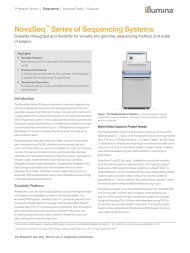Abstracts
ngsfinalprogram
ngsfinalprogram
Create successful ePaper yourself
Turn your PDF publications into a flip-book with our unique Google optimized e-Paper software.
Poster <strong>Abstracts</strong><br />
isolates with varying degrees of antimicrobial<br />
resistance. These results will help to shed light<br />
on the role of epigenetics in antimicrobial<br />
resistance.<br />
n 71<br />
DEVELOPMENT OF A BIONUMERICS<br />
DATABASE AND EVALUATION OF AVERAGE<br />
NUCLEOTIDE IDENTITY USING MUMMER<br />
(ANI-M), RIBOSOMAL MULTI-LOCUS<br />
SEQUENCE TYPING (RMLST), AND RPOB<br />
GENE PHYLOGENY FOR IDENTIFICATION OF<br />
ENTERIC BACTERIA BY WHOLE GENOME<br />
SEQUENCE ANALYSIS<br />
G. Williams 1 , J. Pruckler 1 , R. L. Lindsey 1 , L.<br />
Gladney 1 , A. Huang 1 , L. S. Katz 1 , L. Garcia-<br />
Toledo 1 , S. Im 1 , K. Roache 1 , M. Turnsek 1 ,<br />
Z. Kucerova 1 , D. Stripling 1 , H. Martin 1 , B.<br />
Dinsmore 1 , S. van Duyne 1 , H. Carleton 1 , H.<br />
Pouseele 2 , N. Strockbine 1 , C. Tarr 1 , P. Fields 1 ,<br />
P. Gerner-Smidt 1 , C. Fitzgerald 1 ;<br />
1<br />
Centers for Disease Control and Prevention,<br />
Atlanta, GA, 2 Applied Maths, Sint-Martens-<br />
Latem, BELGIUM.<br />
Background: Conventional phenotypic and<br />
genotypic methods employed for identification<br />
of enteric bacteria, including Campylobacter,<br />
Escherichia, Shigella, Salmonella and Listeria,<br />
are labor-intensive, expensive, and require<br />
multiple workflows. We have begun development<br />
of an Enteric Identification Whole<br />
Genome Sequence (WGS) database. The<br />
PulseNet infrastructure (BioNumerics v 7.5) is<br />
being used to build the database, with the goal<br />
of identifying these enteric bacteria in a single<br />
workflow using WGS. Materials and Methods:<br />
Three different methods are being evaluated<br />
for inclusion in the BioNumerics Enteric<br />
Identification database: 1) Average Nucleotide<br />
Identity using MUMmer (ANI-m), which<br />
describes a pairwise distance between two<br />
genomes, 2) Ribosomal Multi-Locus Sequence<br />
Typing (rMLST), which is a presence/absence<br />
binary phylogeny for ribosomal genes, and 3)<br />
rpoB gene phylogeny, which describes the sequencing<br />
of rpoB and comparing it in a larger<br />
phylogeny. A set of genome assemblies - 157<br />
Campylobacter, 126 Escherichia, 23 Shigella,<br />
and 73 Listeria genomes, representing 23, 5,<br />
4, and 15 species for each genus, respectively<br />
- generated at CDC, provided by external partners,<br />
or publicly available through NCBI were<br />
selected to evaluate the methods. Results:<br />
ANI-m showed identities of ≥95% for members<br />
within a species for the six most common<br />
clinically-relevant Campylobacter species and<br />
≤92% for inter-species comparisons; ≥95%<br />
for members within a species for Escherichia<br />
and Shigella, and ≤90% for inter-species<br />
comparisons; ≥95% for members within a species<br />
for Listeria and ≤91% for inter-species<br />
comparisons. Due to the diversity of its four<br />
lineages, L. monocytogenes had slightly lower<br />
intra-species identity values (≥92%) and interlineage<br />
identity values (≥92% and ≤95%).<br />
Intra-lineage identity values for L. monocytogenes<br />
were consistent with ANI values of other<br />
Listeria species (≥95%). Total allele assignments<br />
for the 53 rMLST loci ranged from 14<br />
to 53 across the validation set, with fewer loci<br />
called for species rarely received at CDC. An<br />
rMLST phylogeny appropriately clustered all<br />
genomes in this evaluation to the species level<br />
when two or more genomes were represented<br />
for a species. Where the full-length rpoB gene<br />
was annotated, phylogenies appropriately clustered<br />
each species, with intra-species similarity<br />
≥91% and ≥95% for subspecies. Conclusions:<br />
This Enteric WGS Identification BioNumerics<br />
database will provide a single, unified,<br />
cost-effective approach for accurate species<br />
identification. Through continued collaboration<br />
with domestic and international partners,<br />
we will continue to test and refine the database<br />
and CLIA validate the reference identification<br />
methods within the next year.<br />
ASM Conference on Rapid Next-Generation Sequencing and Bioinformatic<br />
Pipelines for Enhanced Molecular Epidemiologic Investigation of Pathogens<br />
87



